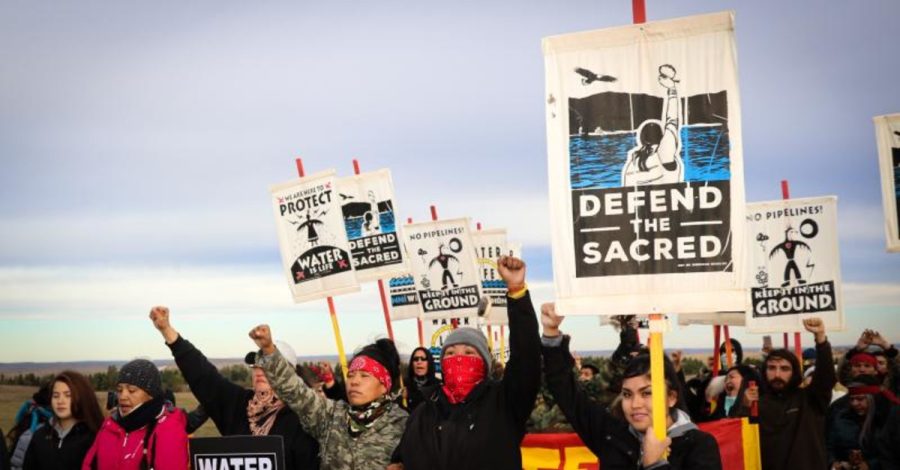The history of the “Land Back” movement
Reframing the meaning of and goals behind the movement that seeks justice for indigenous groups
Protestors advocating for the protection of sacred land in Wisconsin
April 21, 2022
The United States of America is, unfortunately, a nation built on the backs of colonialism and genocide.
Amidst the current wave of social justice in America, it is crucial to understand how the goals of the Land Back movement strive to rectify the damage done to Native American people as a result of European colonization. But the movement is often misunderstood or misrepresented by many Americans.
To understand “Land Back,” you have to understand the intended relationship between the United States and Native communities. The U.S. constitution recognizes Native reservations as sovereign nations, not governed by the U.S., but rather by members of their own communities. To ensure that this would remain the case, the U.S. signed roughly 370 treaties with Native communities that recognized the sovereignty of the U.S.
Unfortunately, most of these treaties have been broken or violated by the U.S. government in some way, shape, or form. For instance, Mount Rushmore was illegally built on land given to the Lakota people in the Treaty of Fort Laramie in 1868. Another structure, depicting Oglala Lakota leader Crazy Horse, is currently being constructed on the same land, despite protests from descendants of Crazy Horse himself. In 1778, a Pennsylvania militia invaded land given to the Lenape people in the Treaty of Fort Pitt, killing roughly 100 Lenape people. Colonial intrusion on Native lands has and will continue to result in the mass death and destruction of Native American populations.
When asked about the cause of the decline in the Native American population in the 1500s, RV Genocide Studies teacher Mrs. Sara Shelley quoted a History.com article that attributed the population decline to old world diseases like measles, chickenpox and the bubonic plague, which the Americans had no immunity to. The Indian Removal Act and subsequent Trail of Tears is estimated to have killed 15,000 people via forced relocation and ethnic cleansing. European colonists have consistently trampled Native American nations and communities in a blatant show of disrespect for America’s purported values. The primary goal of the Land Back movement is to restore the sovereignty of Native American nations, and allow them to function independently of the U.S. government.
As a result of the U.S.’s interference in Native nations, most Native American reservations are dependent on the U.S. and U.S.-based companies for basic utilities like water and electricity. However, evidence points to the notion that U.S. utility companies often neglect Native communities, providing them with subpar services. Native reservations like the North Indian Springs Reservation in Oregon often go months without clean drinking water, and the Navajo community of To’hajiilee in New Mexico frequently has its tap water contaminated with substances that turn it brown and orange.
There is also evidence that other U.S. services, like the FBI, often neglect Native American reservations as well. There are 576 Native reservations in the United States, yet the FBI only has “legal responsibility” for 200.
Because the U.S. has jurisdiction over all Native lands, they’ve implemented various arbitrary restrictions that prevent Native communities from establishing their own utilities or law enforcement entities. To obtain a permit, an energy company based on a Native reservation must go through four federal agencies and complete 49 tedious steps, compared to as few as four steps outside of Native land.
Furthermore, because all land on Native American reservations is federal land, people living on such reservations cannot mortgage their property.
Without liberation from the U.S., Native reservations will always be bound to the subpar service of U.S. federal agencies and U.S.-based utility companies that will likely never have their best interests at heart.
Oftentimes, the LandBack movement is misinterpreted as support for an indigenous ethnostate in the United States. Critics of Land Back will allege that the movement advocates for the removal of all non-Native people in the United States. This could not be further from the truth. LandBack advocates the sovereignty and recognition of Native American nations as countries separate from the U.S., not the establishment of a Native-only nation-state. Although all Native American nations were founded by Native Americans, they are not Native American ethnostates, and there are no restrictions on what races can live on the Native reservations.
The Land Back movement doesn’t advocate for the separation or segregation of Native Americans from the rest of the U.S. population, it advocates for the liberation of Native communities from the United States. An examination of the relationship between the U.S. and Native American communities will reveal that the U.S. was founded on the trampling and sidelining of Native Americans. The U.S. is, by all means, a settler colony. Since 1607, the U.S. has created an oppressive, British Crown-esque environment in Native communities and countries all across the global south, all while claiming to stand behind the same principles that fueled the American Revolution.
Freedom for those living in settler colonies, not just in mainland America, but in places like Palestine and Puerto Rico, should be an idea that every patriotic American should stand behind.






